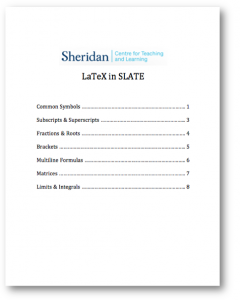LaTeX Equation
LaTeX is a typesetting system which allows you to type complicated mathematical formulas into SLATE by hand. Although it involves a bit of a learning curve to understand all of the commands, once mastered, using the LaTeX Equation editor is a quick, efficient, and powerful tool for users who plan on inserting many mathematical statements into their course.
LaTeX Commands
All letters, numbers, and the following symbols can be entered using your keyboard as usual:
+ – * / = < > ( ) [ ] | ! ? ” ‘ : ; , .
Browse through the following pages to learn the different mathematical LaTeX commands, or click the image to the right to download them all in a manual.
- Common Symbols
- Subscripts & Superscripts
- Fractions & Roots
- Brackets
- Multiline Formulas
- Matrices
- Limits & Integrals
NOTE: This is not a comprehensive list of LaTeX commands. If you are looking for a symbol not found on these pages, try Googling the LaTeX command for it.
Inserting an Equation
- Select the triangle on the right of the
 symbol, and from the drop-down menu select LaTeX Equation.
symbol, and from the drop-down menu select LaTeX Equation. - In the pop-up window, use your keyboard to enter your LaTeX commands to create your mathematical statement.
- Select Insert when you are done.
- While editing your text, your mathematical statement will appear as a beige box. Once you publish your text, it will appear as it is supposed to:
LaTeX Examples
There are several simpler examples of how to create each individual element of a formula in LaTeX in the manual above. The following examples are simply to give a taste of what well-known formulas look like in LaTeX.
|
|
Quadratic Formulax= \frac{-b \pm \sqrt{b^2 -4ac}}{2a} |
|
|
2×2 Matrix Determinant Formuladet \left[ \begin{array}{cc} |
|
|
Triangular Number Formula\sum_{k=1}^n k=1+2+ \cdots +n= \frac{n(n+1)}{2} |





